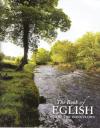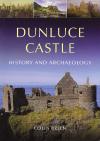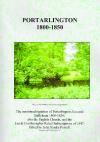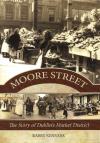Bookworm
Published in Book Reviews, General, Issue 1(Jan/Feb 2013), Reviews, Volume 21 Bookworm has always had a soft spot for local history, and some very handsome examples of the genre have appeared in recent times. First up is a truly magnificent production: the Eglish Historical Society’s stunning The book of Eglish, where the Oona flows (Eglish Historical Society, 512pp, hb, no price given, ISBN 9781905989263). All human life—at least within the eponymous area of County Tyrone—can be found in its pages, and this book is a genuine cross-community venture that is a remarkable testament to what community history can achieve. Those who might snootily dismiss local history as the province of ‘amateurs’ deserve a belt of this hefty tome, the lavish production of which was funded by the UK’s Heritage Lottery Fund: public money well spent. The same can be said of Colin Breen’s superbly produced Dunluce Castle: history and archaeology (Four Courts Press, 272pp, €19.95 pb, ISBN 9781846823732), which received financial assistance from the Northern Ireland Environment Agency. This is a serious but very readable work of scholarship that explores the history and archaeology of north Antrim from the Middle Ages to the present through a study of Northern Ireland’s ‘most visited public monument’. Finally, we’ll end our brief round-up of local history from Northern Ireland with a more modest study: Colm Rooney’s engaging and thorough Strangford: portrait of a village, 1901–1911 (Lecale and Down Historical Society, 100pp, £10 pb, ISBN 9780957371804).
Bookworm has always had a soft spot for local history, and some very handsome examples of the genre have appeared in recent times. First up is a truly magnificent production: the Eglish Historical Society’s stunning The book of Eglish, where the Oona flows (Eglish Historical Society, 512pp, hb, no price given, ISBN 9781905989263). All human life—at least within the eponymous area of County Tyrone—can be found in its pages, and this book is a genuine cross-community venture that is a remarkable testament to what community history can achieve. Those who might snootily dismiss local history as the province of ‘amateurs’ deserve a belt of this hefty tome, the lavish production of which was funded by the UK’s Heritage Lottery Fund: public money well spent. The same can be said of Colin Breen’s superbly produced Dunluce Castle: history and archaeology (Four Courts Press, 272pp, €19.95 pb, ISBN 9781846823732), which received financial assistance from the Northern Ireland Environment Agency. This is a serious but very readable work of scholarship that explores the history and archaeology of north Antrim from the Middle Ages to the present through a study of Northern Ireland’s ‘most visited public monument’. Finally, we’ll end our brief round-up of local history from Northern Ireland with a more modest study: Colm Rooney’s engaging and thorough Strangford: portrait of a village, 1901–1911 (Lecale and Down Historical Society, 100pp, £10 pb, ISBN 9780957371804).
 South of the border, some public funds were used to aid the production of The combined registers of Portarlington, Lea and Ballykean 1800–1850 (Frenchchurch Press, 202pp, €25 pb, ISBN 9780953801091), edited by John Stocks Powell. This does exactly what it says by publishing genealogical information culled from the parochial registers of the largely Huguenot town of Portarlington. It sounds churlish to criticise the obvious and admirable work that has gone into this undeniably useful anthology, but books of this kind are rapidly being overtaken by genealogical databases, which would surely offer a more user-friendly format for the information it contains.
South of the border, some public funds were used to aid the production of The combined registers of Portarlington, Lea and Ballykean 1800–1850 (Frenchchurch Press, 202pp, €25 pb, ISBN 9780953801091), edited by John Stocks Powell. This does exactly what it says by publishing genealogical information culled from the parochial registers of the largely Huguenot town of Portarlington. It sounds churlish to criticise the obvious and admirable work that has gone into this undeniably useful anthology, but books of this kind are rapidly being overtaken by genealogical databases, which would surely offer a more user-friendly format for the information it contains.
 Photographs need not play second fiddle to a text. Having curated the photo exhibition ‘Small Lives’ in the National Library, Aoife O’Connor now brings it into print. Small lives: photographs of Irish childhood, 1860–1970 (Gill & Macmillan, 216pp, €29.99 hb, ISBN 9780717154623) reproduces 140 images of Irish people, all under the age of fifteen, scattered across a century. Another collection of historical photographs confines itself to a single decade: an intriguing series continues with Mary Webb (ed.), The 1950s: Ireland in pictures (O’Brien Press, 160pp, €14.99, ISBN 9781847173195). Like its predecessor on the 1960s, the images are culled from the Lensmen Photographic Archive. The 1950s usually get written off in Ireland as a miserable decade, but the diversity of these images is a reminder that the complexities of a period can never be reduced to a soundbite. Bookworm was struck by the fact that an exhibition of American football took place in Croke Park in 1953—rule 42 and all that?
Photographs need not play second fiddle to a text. Having curated the photo exhibition ‘Small Lives’ in the National Library, Aoife O’Connor now brings it into print. Small lives: photographs of Irish childhood, 1860–1970 (Gill & Macmillan, 216pp, €29.99 hb, ISBN 9780717154623) reproduces 140 images of Irish people, all under the age of fifteen, scattered across a century. Another collection of historical photographs confines itself to a single decade: an intriguing series continues with Mary Webb (ed.), The 1950s: Ireland in pictures (O’Brien Press, 160pp, €14.99, ISBN 9781847173195). Like its predecessor on the 1960s, the images are culled from the Lensmen Photographic Archive. The 1950s usually get written off in Ireland as a miserable decade, but the diversity of these images is a reminder that the complexities of a period can never be reduced to a soundbite. Bookworm was struck by the fact that an exhibition of American football took place in Croke Park in 1953—rule 42 and all that? Local history can, and does, accommodate awkward realities. A case in point is the subject of Jim Madden’s Fr John Fahy: radical republican and agrarian activist (1893–1969) (Columba Press, 272pp, €19.99 pb, ISBN 9781856077637). The formidable Fr Fahy served in the diocese of Clonfert (having been a member of the IRB in his youth), but in the Ireland of the 1950s he became a ferocious and vocal champion of the vanishing rural poor of the west of Ireland. As Gearóid Ó Tuathaigh points out in his foreword, ‘few will deny that he had strong convictions and a genuine concern . . . for the plight of the rural smallholders’, but ‘he was habitually intemperate in public controversy’ and ‘prone to xenophobic statements’. A saint or a sinner? Readers can decide for themselves thanks to this well-documented biography. Another turbulent priest is the subject of Tim Boland’s Father John Kenyon: the rebel priest (Tim Boland, 274pp, €20 hb, ISBN 9781901370362). The Tipperary curate was a Young Irelander and a vocal advocate of physical-force nationalism—a curious combination for a man of the cloth in the age of O’Connell, whom Kenyon vociferously opposed.
Local history can, and does, accommodate awkward realities. A case in point is the subject of Jim Madden’s Fr John Fahy: radical republican and agrarian activist (1893–1969) (Columba Press, 272pp, €19.99 pb, ISBN 9781856077637). The formidable Fr Fahy served in the diocese of Clonfert (having been a member of the IRB in his youth), but in the Ireland of the 1950s he became a ferocious and vocal champion of the vanishing rural poor of the west of Ireland. As Gearóid Ó Tuathaigh points out in his foreword, ‘few will deny that he had strong convictions and a genuine concern . . . for the plight of the rural smallholders’, but ‘he was habitually intemperate in public controversy’ and ‘prone to xenophobic statements’. A saint or a sinner? Readers can decide for themselves thanks to this well-documented biography. Another turbulent priest is the subject of Tim Boland’s Father John Kenyon: the rebel priest (Tim Boland, 274pp, €20 hb, ISBN 9781901370362). The Tipperary curate was a Young Irelander and a vocal advocate of physical-force nationalism—a curious combination for a man of the cloth in the age of O’Connell, whom Kenyon vociferously opposed.
 Finally, on a lighter note, there is Joe O’Shea’s luridly titled An account of murder, mutiny and mayhem concerning the affairs of the blackest-hearted villains from Irish history (O’Brien Press, 265pp, €12.99, ISBN 9781847172990). One of these villains is Limerick’s own Sir Hugh Gough, who commanded British land forces during the Opium War of 1839–42. O’Shea can therefore describe him as the ‘most ruthless, brutal, and successful drug lord in history’ without too much hyperbole, given his role in forcing the Chinese to accept the British willingness to trade in opium. Naturally, Gough was commemorated with a statue in the Phoenix Park. Its unveiling was the first childhood memory of Winston Churchill, while an attempt by republicans to blow it up in 1957 was noted in a bitingly satirical verse by the Dublin printer Vincent Caprani. When reflecting on some of the more curious things that went on in the park, he concluded that ‘the strangest of all within human recall/Concerns the statue of Gough/’Twas a terrible fact, and a most wicked act/For his bollix they tried to blow off!’ HI
Finally, on a lighter note, there is Joe O’Shea’s luridly titled An account of murder, mutiny and mayhem concerning the affairs of the blackest-hearted villains from Irish history (O’Brien Press, 265pp, €12.99, ISBN 9781847172990). One of these villains is Limerick’s own Sir Hugh Gough, who commanded British land forces during the Opium War of 1839–42. O’Shea can therefore describe him as the ‘most ruthless, brutal, and successful drug lord in history’ without too much hyperbole, given his role in forcing the Chinese to accept the British willingness to trade in opium. Naturally, Gough was commemorated with a statue in the Phoenix Park. Its unveiling was the first childhood memory of Winston Churchill, while an attempt by republicans to blow it up in 1957 was noted in a bitingly satirical verse by the Dublin printer Vincent Caprani. When reflecting on some of the more curious things that went on in the park, he concluded that ‘the strangest of all within human recall/Concerns the statue of Gough/’Twas a terrible fact, and a most wicked act/For his bollix they tried to blow off!’ HI
















